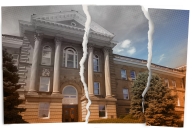You have /5 articles left.
Sign up for a free account or log in.
The share of federal student loan borrowers who default on their debt within three years of entering repayment dropped for the second year in a row, the U.S. Department of Education announced Wednesday.
The national default rate on student loans made by the government fell to 11.8 percent from 13.7 percent last year, the department said. Obama administration officials credited their success in getting more borrowers to sign up for income-based repayment plans for some of the decline in defaults.
This year’s data capture the number of borrowers whose loans first became due during the 2012 fiscal year and who then defaulted on their debt within three years. Nationwide, more than 610,000 borrowers defaulted during that period.
Colleges that have high default rates are subject to losing their eligibility for federal student aid funding. The department said Wednesday that 15 institutions -- 12 for-profit colleges, two community colleges and one private, nonprofit institution -- are now facing penalties because of their default rates.
Education Secretary Arne Duncan praised the lower default rate but said there is more work to do.
“There’s no real reason why we can’t significantly reduce default rates even further,” he told reporters. “We’re going to keep working to hold schools accountable.”
Rates Adjusted Again
The Obama administration again this year helped some colleges avoid those penalties for their high default rates by not holding some colleges responsible for defaulted loans that met certain criteria. That policy last year proved controversial, with both Democrats and Republicans in Congress criticizing the Education Department’s unusual decision to adjust colleges’ default rates downward.
A department official, who declined to be named, told reporters that the department retroactively lowered the default rates published in previous years for “fewer than a dozen” colleges that would have otherwise faced penalties this year.
Officials said they made the adjustment to account for the impact of “split-servicing” -- a circumstance that arises when borrowers, usually because of a bureaucratic glitch, end up with two loan servicers that collect different portions of their federal student loan debt.
For the colleges on the verge of losing their federal aid, the department said it didn’t count a default against the institution if the borrower had defaulted on one portion of his or her federal student loan debt but not the other segment.
Debbie Cochrane, research director at the Institute for College Access and Success, an advocacy group that closely follows default rates, said that the department’s adjustment of the rates again raises concerns.
“There are broad concerns about how the department adjusted default rates last year, including the undermining of core college accountability measures and the undermining of transparency,” she said.
The default rate adjustments are also “patently unfair,” she said, because the department holds the borrower responsible for the default but “gives the college a pass” on it.
“Any time the department is going to be removing a borrower from a college’s default rate, they need to remove the default for the borrower as well,” she said.
Colleges are subject to sanctions when their default rate is 30 percent or greater for three consecutive years (or if the default rate spikes to above 40 percent in one year). Last year, in removing some defaulted loans because of the split-servicing issue, the department made changes to some colleges’ default rates from that year and the two previous years.
This year, the department lowered colleges’ default rates for the two previous years -- those that were published in 2014 and 2013, which reflected cohorts of borrowers entering repayment in the federal fiscal years 2011 and 2010, respectively.
A department official said that the department did not make any unusual adjustments to the current-year rates because it had instructed its loan servicers to manually “fix” the issue.
“After completing the [default rate] adjustments last year, [the department] undertook a project with its servicers to manually review split statuses at the borrower level to evaluate and fix, where appropriate, the loan status for the individual borrower in the [fiscal year 2012] cohort,” an official said in an email.
The department did not provide more information on what that project entailed. It has also declined to name which colleges and universities benefited from the downward adjustment of their default rates. Officials have not responded to Inside Higher Ed’s Freedom of Information Act request for such information that was made almost one full year ago.
Are Defaults the Right Metric?
Even beyond the controversy over how the Obama administration handled a small number of colleges’ default rates, there is widespread dissatisfaction with the rigor of federal default rates as a way to hold colleges accountable for student outcomes.
Critics of the default rates argue that the metric severely understates how many of a college’s former students are actually struggling to repay their debt.
Even as the default rate on federal student loans has dropped, for instance, the Consumer Financial Protection Bureau this week estimated that one out of every four student loan borrowers is either in default or behind on payments.
The Education Department recently published data on the loan repayment rates of individual colleges' borrowers, which some see as a tougher and better way of gauging the fate of student loan borrowers.








